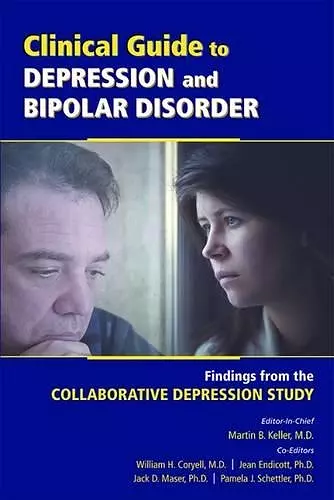Clinical Guide to Depression and Bipolar Disorder
Findings From the Collaborative Depression Study
Jack D Maser editor Martin B Keller editor William H Coryell editor Jean Endicott editor Pamela J Schettler editor
Format:Paperback
Publisher:American Psychiatric Association Publishing
Published:9th Jun '13
Currently unavailable, and unfortunately no date known when it will be back

The Collaborative Depression Study is a monumental contribution to the field of mood disorders beyond comparison. It represents a gold standard example of evidence-based guidelines for clinicians and patients in regards to course of illness and treatment implications in mood disorders. Mauricio Tohen, M.D., Dr.P.H., M.B.A., Chair, Department of Psychiatry, School of Medicine, University of New Mexico, Albuquerque, NM This book memorializes one of the most important and innovative studies ever funded by NIMH. It is both a history and a primer of how the longitudinal study of mood disorders developed in the United States. The authors describe not only how instruments commonly employed by clinicians and researchers were developed but how their systematic use led to many of the fundamental tenets that are the foundation for our modern understanding of mood disorders. It is an invaluable work for any clinician or researcher to have. Mark Hyman Rapaport, M.D., Reunette W. Harris Professor & Chairman, Dept of Psychiatry & Behavioral Sci, Emory Univ School of Med; Chief of Psychiatric Services, Emory Healthcare; Co-Editor of FOCUS
This book builds on research from the influential NIMH Collaborative Depression Study (CDS) to provide clinicians with information they can use to assess, diagnose, treat, and understand how their patients will likely fare over the course of their illness.
Conceived in the early 1970s to study the phenomenology, diagnosis, genetics, and clinical course of depression, the NIMH Collaborative Depression Study (CDS) has influenced research and practice since its inception. Clinical Guide to Depression and Bipolar Disorder: Findings From the Collaborative Depression Study summarizes key findings from the study and the related literature to provide comprehensive and up-to-date knowledge on the course and outcome of illness in mood disorders. Nowhere else can clinicians find such detailed longitudinal data, combined with astute clinical analysis of the current research. The volume offers:
• Historical background on how psychodynamic psychiatry was overtaken by psychobiological perspectives, and the challenges and controversies that gave rise to the CDS, providing the context necessary to understand the profession's development to the present day.
• A wealth of information on nosology, natural history, phenomenology, and treatment response in depressive and bipolar disorders.
• Detailed descriptions of the study methods employed, providing information and insights that will assist researchers in the longitudinal design of prospective cohort studies.
• Comprehensive review of outcomes in mood disorder, including delineation of the long-term course of bipolar I, bipolar II, and unipolar major depressive disorders, the implications of which will continue to be instrumental in the development of psychiatric nosology and indispensable to clinicians engaged in assessment and treatment.
• Critical information clinicians need in order to read the clinical signs in their patients and predict the "switch" from unipolar to bipolar disorder.
• A fascinating review of the evolution of diagnostic thinking about the role of anxiety in mood disorders, and the contributions of the CDS to the newly published DSM-5.
Each chapter is accompanied by a time-saving summary, as well as a section on clinical implications that translates the findings into practical points and key recommendations clinicians need to know to provide optimal care. Psychiatrists, clinical psychologists, residents, and fellows will turn to Clinical Guide to Depression and Bipolar Disorder: Findings From the Collaborative Depression Study to better understand the course and outcome of their patients' mood disorders and, ultimately, to improve their clinical skills.
The CDS is without a doubt one of the longest and most intensive psychiatric studies ever conducted. At least 285 empirical reports have been published based on CDS findings, and the CDS has led to a rethinking of the terminology of mood disorders and a new appreciation of their devastating, long-term course. A study of such extraordinary magnitude and paramount importance demands a book to summarize its key findings. This is that book.
-- Bradley R. Cutler, M.D. * Doody's Book ReviISBN: 9781585624331
Dimensions: 229mm x 152mm x 12mm
Weight: 390g
234 pages